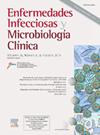在感染性心内膜炎、心脏起搏装置感染和菌血症中使用达巴万星作为巩固抗生素疗法:7 年临床经验
IF 2.6
4区 医学
Q3 INFECTIOUS DISEASES
Enfermedades infecciosas y microbiologia clinica
Pub Date : 2025-02-01
DOI:10.1016/j.eimc.2024.02.010
引用次数: 0
摘要
dalbavancin (DBV)是一种具有抗革兰氏阳性细菌感染活性的新型脂糖肽,已被批准用于治疗急性细菌性皮肤和皮肤结构感染。它具有线性剂量相关的药代动力学,允许剂量之间的间隔延长。这将是治疗革兰氏阳性心血管感染患者的一个很好的选择。材料与方法回顾性分析Clínico San Carlos (Madrid)医院2016-2022年7年间接受DBV治疗的心血管感染(菌血症、植入式电子设备感染和感染性心内膜炎[IE])患者。患者分为2个研究组:1)IE组和2)菌血症组。分析流行病学、临床、微生物学和治疗资料。结果25例患者接受了DBV治疗。IE是最常见的适应症(68%),其次是菌血症(32%),两组均以男性为主(64对62%),中位年龄分别为67,7岁和57.5岁。在两个研究组中,100%的血液培养对革兰氏阳性微生物(葡萄球菌、链球菌或肠球菌)呈阳性。在DBV之前,所有患者都接受了其他抗生素治疗,包括IE组(中位数:80天)和菌血症组(14.8天)。在EI组(n = 15)和菌血症组(n = 8)中,使用DBV的主要原因是在院外继续静脉抗菌治疗。DBV作为巩固治疗,每周一次或两次。微生物学和临床成功率为84%(21例),IE组为76.4%,菌血症组为100%。在长期DBV治疗期间,无患者记录不良反应。结论dbv作为巩固抗生素治疗革兰氏阳性菌引起的IE和菌血症是一种安全有效的治疗方法。本文章由计算机程序翻译,如有差异,请以英文原文为准。
Dalbavancina como tratamiento antibiótico de consolidación en endocarditis infecciosa, infección de dispositivos de estimulación cardiaca y bacteriemia: experiencia clínica de 7 años
Introduction
Dalbavancin (DBV), a novel lipoglycopeptide with activity against Gram-positive bacterial infections, is approved for the treatment of acute bacterial skin and skin structure infections. It has linear dose-related pharmacokinetics allowing a prolonged interval between doses. It would be a good option for the treatment of patients with Gram-positive cardiovascular infections.
Material and methods
Retrospective analysis of patients with cardiovascular infection (bacteremia, implantable electronic device infection and infective endocarditis [IE]) treated with DBV at Hospital Clínico San Carlos (Madrid) for 7 years (2016-2022). Patients were divided into 2 study groups: 1) IE, and 2) bacteremia. Epidemiological, clinical, microbiological and therapeutic data were analyzed.
Results
A total of 25 patients were treated with DBV for cardiovascular infection. IE was the most common indication (68%), followed by bacteremia (32%) with male predominance in both groups (64 vs. 62%) and median age of 67,7 and 57,5 years, respectively. Hundred percent of blood cultures were positive to Gram-positive microorganisms (Staphylococcus spp., Streptococcus spp. or Enterococcus spp.) in both study groups. Previously to DBV, all patients received other antibiotic therapy, both in the group of IE (median: 80 days) as in bacteremia (14,8 days). The main reason for the administration of DBV was to continue intravenous antimicrobial therapy outside the hospital in both the EI group (n = 15) and the bacteremia group (n = 8). DBV was used as consolidation therapy in a once- or twice-weekly regimen. Microbiological and clinical successes were reached in 84% of cases (n = 21), 76,4% in IE group and 100% in bacteremia group. No patient documented adverse effects during long-term DBV treatment.
Conclusion
DBV is an effective and safety treatment as consolidation antibiotic therapy in IE and bacteremia produced by Gram-positive microorganisms.
求助全文
通过发布文献求助,成功后即可免费获取论文全文。
去求助
来源期刊
CiteScore
2.10
自引率
8.00%
发文量
194
审稿时长
29 days
期刊介绍:
Hoy está universalmente reconocida la renovada y creciente importancia de la patología infecciosa: aparición de nuevos agentes patógenos, de cepas resistentes, de procesos con expresión clínica hasta ahora desconocida, de cuadros de una gran complejidad. Paralelamente, la Microbiología y la Infectología Clínicas han experimentado un gran desarrollo como respuesta al reto planteado por la actual patología infecciosa. Enfermedades Infecciosas y Microbiología Clínica es la Publicación Oficial de la Sociedad Española SEIMC. Cumple con la garantía científica de esta Sociedad, la doble función de difundir trabajos de investigación, tanto clínicos como microbiológicos, referidos a la patología infecciosa, y contribuye a la formación continuada de los interesados en aquella patología mediante artículos orientados a ese fin y elaborados por autores de la mayor calificación invitados por la revista.

 求助内容:
求助内容: 应助结果提醒方式:
应助结果提醒方式:


